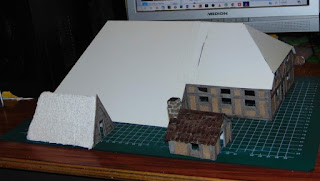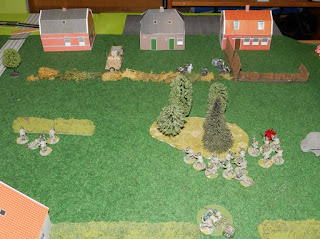I came across this pic of a building described as "Jewish". Since I was straight out of Jewish coffee stirrers I made mine non-denominational.
Though the final result is IMNSHO satisfactory, there were a few bumps in the road when scratch building this model.
The pic that started it all:
The basic model, out of styrene:
The door- and window frames put in, made out of match sticks.
The front wall clad with coffee stirrers.
When the glue had dried, I found the wall bent considerably. To fix it I added a ceiling
.
All four walls clad, and assembled.
Roof and chimneys added.
Small remark on the lines where the seams between the zinc roofing were to come: Do not use a permanent marker, like I did, but rather a pencil. The marker bled right through glue and primer. No big problem in this case, but something to remember.
Some reinforcement was added to the roof to keep it in shape.
The roofing seams added, the woodwork primed.
I wanted to use a new (for me at least) painting technique: a wash over the absorbent wood primer, and the less so neglected green paint, and spray primer used for the roof.
It worked well for the walls, nut the wash didn't work at all with the primer used for the roof, so I aged that by rubbing it with brown paint.
As I said at the beginning, a few minor hiccups during the construction, but in the end a very usable addition to my Polish village project.


















































